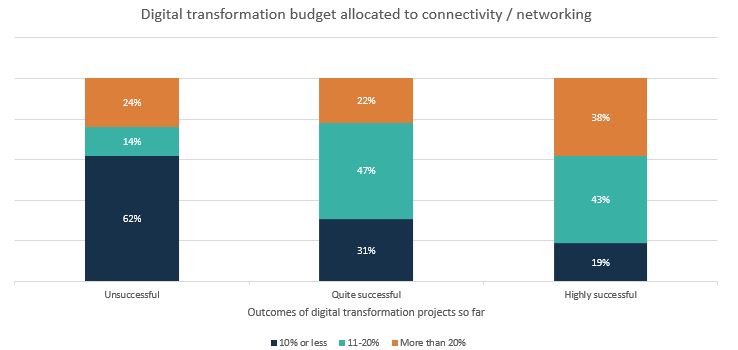It’s well documented that digital transformation has been on the agenda for many businesses across a multitude of industries for some time now. But with the COVID-19 pandemic significantly impacting many sectors from early 2020, plans to digitise operations, systems and processes were accelerated in order for many to adapt and survive.
We wanted to understand the extent in which UK organisations were making progress and building out their digital strategies around activities, including cloud migration and digital transformation. Moreover, we were keen to understand the extent to which connectivity is being considered as part of these transformation plans.
With this in mind, we conducted a survey to almost 250 respondents across various verticals in the UK, getting under the skin of their digital transformation strategies. We were eager to learn more about when connectivity was considered in the process, the level of investment in network infrastructure and the ways in which organisations are implementing forward looking solutions to maintain sustainability.
Working with B2B International in a survey conducted throughout the first half of 2021, it was possible to unearth a number of interesting, and sometimes alarming, facts around the attitudes towards connectivity and network infrastructure.
From our findings, perhaps most pertinent was that 65% of respondents expected reliance on connectivity solutions to increase in the future, while 64% agreed that their digital transformation projects were at high risk of failure due to poor or inadequate connectivity. And yet, fewer than half (45%) of organisations include connectivity and networking requirements as part of their digital transformation roadmaps, while just four out of ten (41%) deem it a high priority.
There is an obvious disconnect here, and one which could prove costly given the average budget dedicated to digital transformation among large organisations is £14m. Thankfully, our research did also reveal a cohort of respondents for whom a very positive correlation was observed; the 28% that reported their digital transformation programmes to have progressed with a high level of success.
Within this group, we observed significant correlation between the level of focus and attention attributed to connectivity in comparison to those who have endured unsuccessful digital transformation programmes. For example, our research revealed that at least 11% of total digital transformation budget was allocated to connectivity for eight out of ten (81%) successful programmes. For the 62% of programmes that failed, budget attribution was 10% or less.

This was not an isolated occurrence. Consistently, organisations that had succeeded in their digital transformation projects had also focused considerable attention upon the importance of connectivity. As such, it was possible to construct a 14-point framework; a set of success factors to which organisations should adhere when looking to embark on digital transformation journeys. These centred around five key mantras:
- Prioritise connectivity: regardless of the technologies you might be implementing as part of your transformation programme, appropriate resource should be made available to ensure adequate connectivity is in place to optimise operations.
- Improve connection quality for cloud solutions: with the transition to forward-facing cloud technologies under way, it’s imperative that connectivity solutions are future-proofed and offering the capacity capable of dealing with exponentially increasing demands on data.
- Address connectivity challenges of hybrid work: the way we work is changing. Connectivity should not be delivered using a ‘one size fits all’ approach. Organisations must adapt accordingly and provide the capacity, resilience and security to remote sites just as they would a central HQ.
- Enhance visibility, security and control: businesses should be involving and, more importantly, empowering IT teams from the outset. Supporting their recommendations for connectivity solutions specific to individual SaaS and cloud solutions, while also appreciating the value SD-WAN has to offer in this regard.
- Recruit the right connectivity partners: your connectivity partner should be supportive of your digital transformation ambitions, offering strategic advice and providing solutions designed to add value. If you can’t score them highly for levels of satisfaction, perhaps it’s time to consider an alternative vendor…
In the current climate, digital transformation must be delivered at an accelerated rate, and in some industries, it could be the determiner of survivability. You can explore our 14-point success framework in greater depth as part of our report, Core connectivity: The key enabler of digital transformation. Take a look today and give your organisation the best shot of joining that elite group of businesses winning when it comes to digital transformation success.





